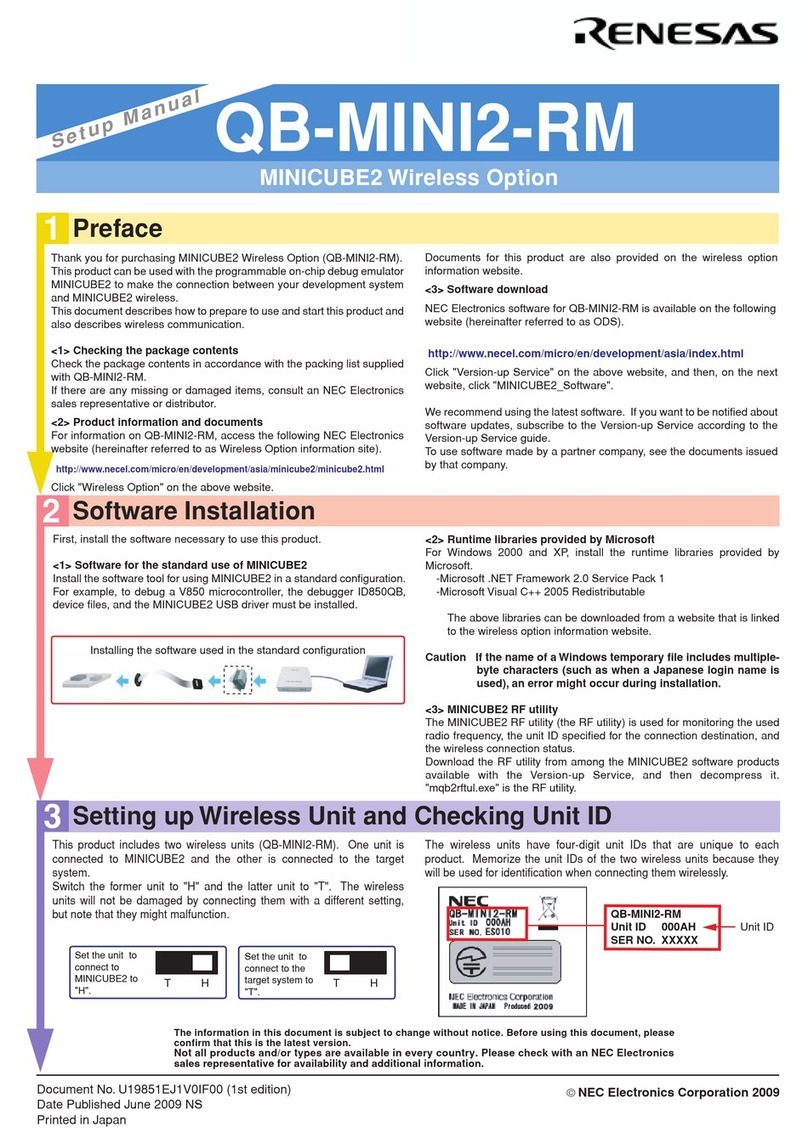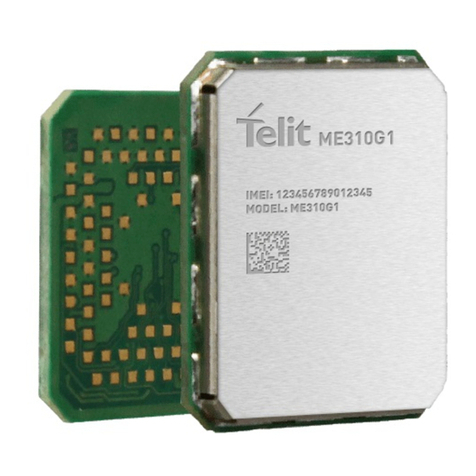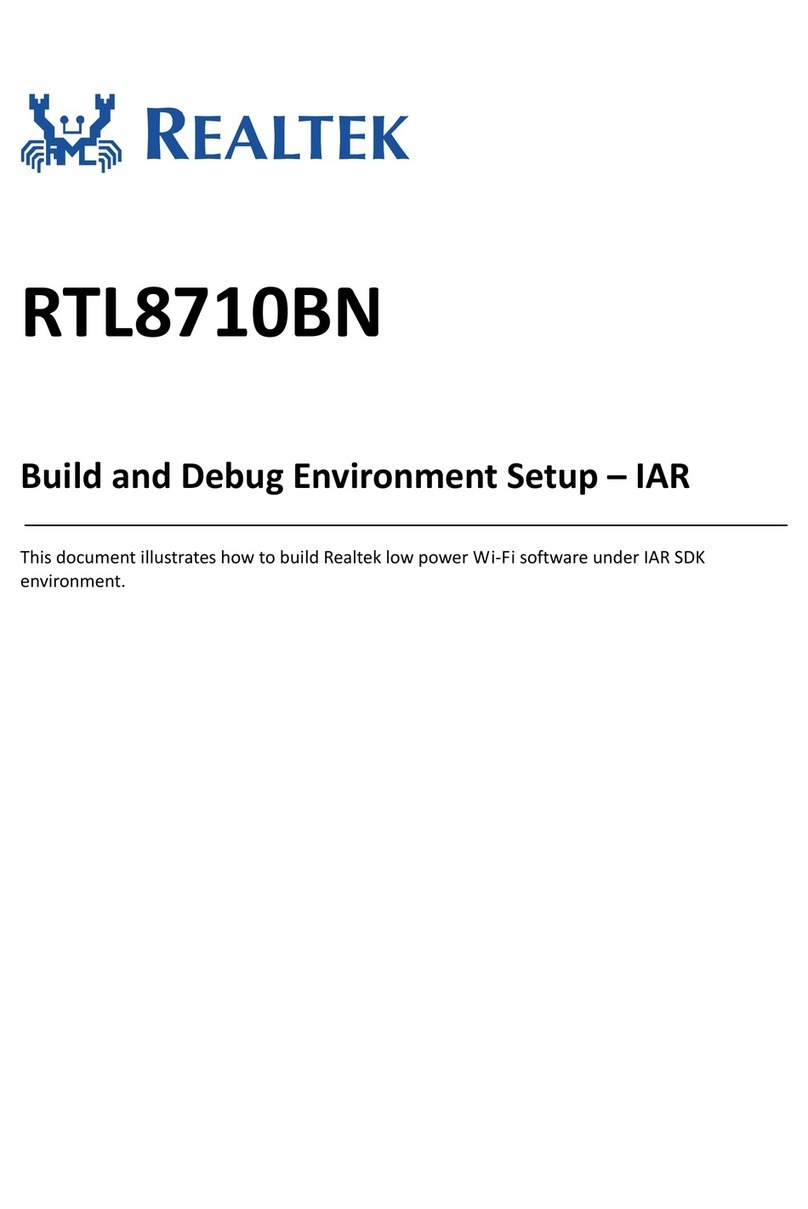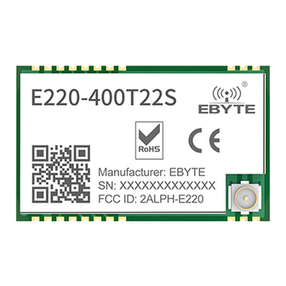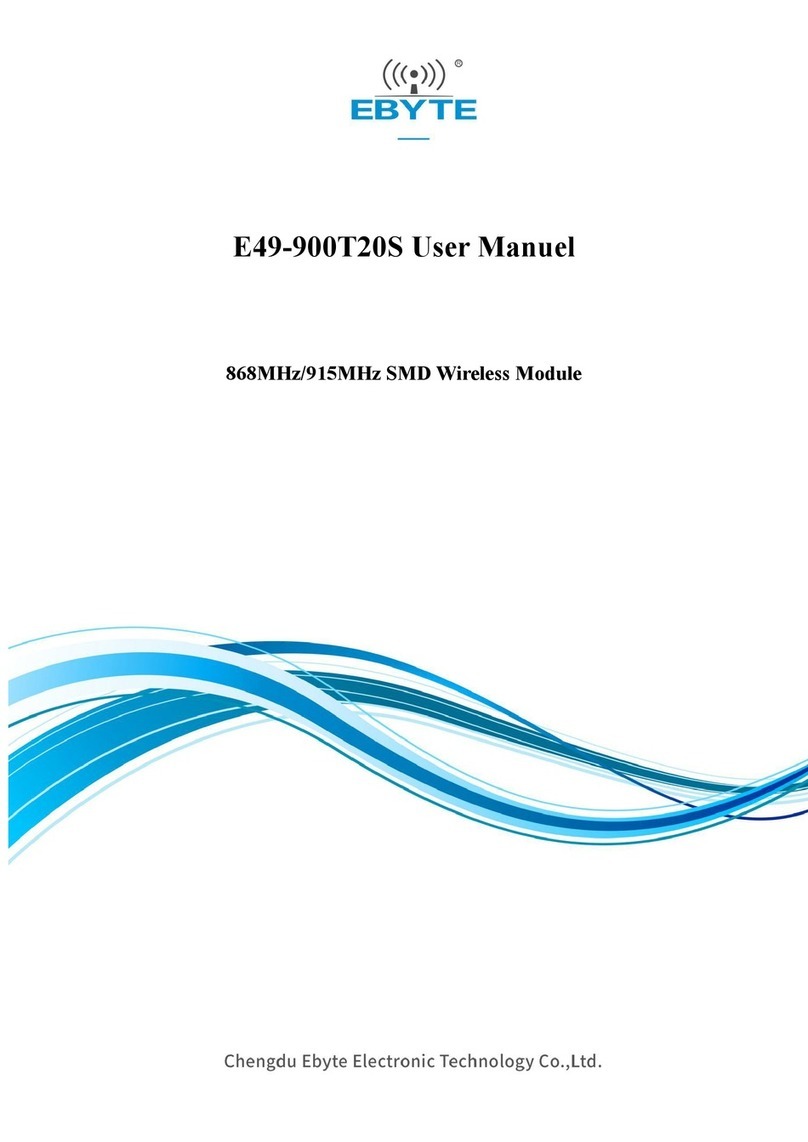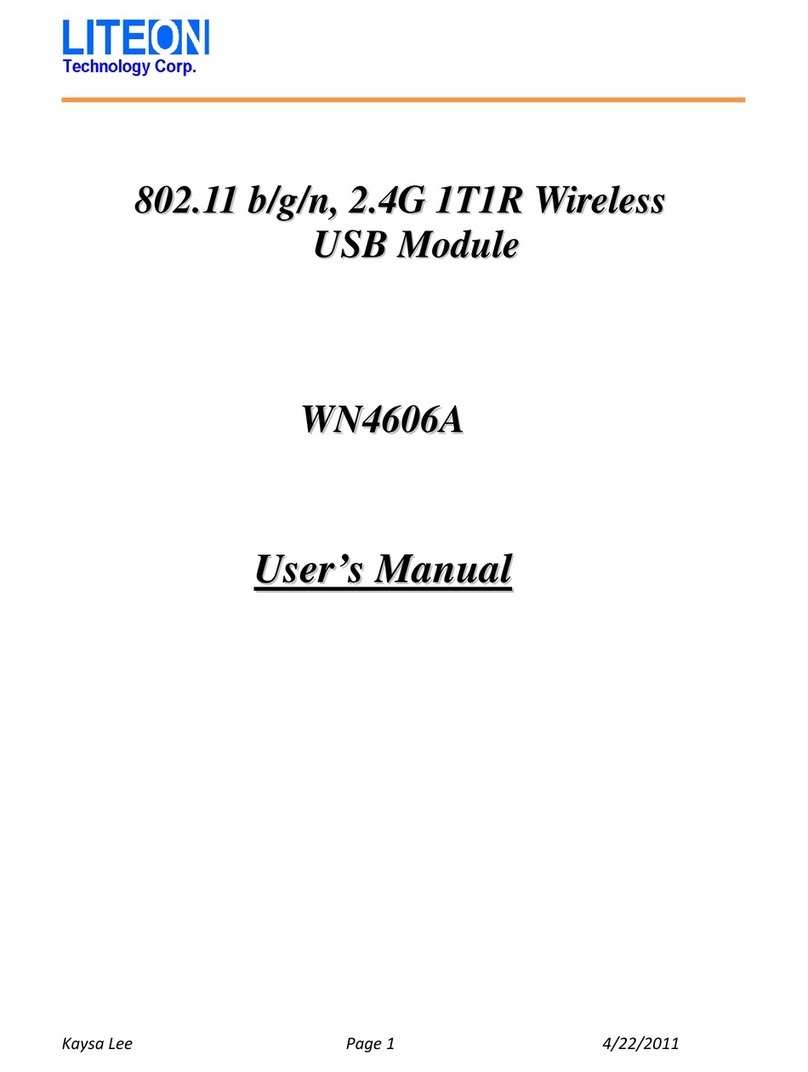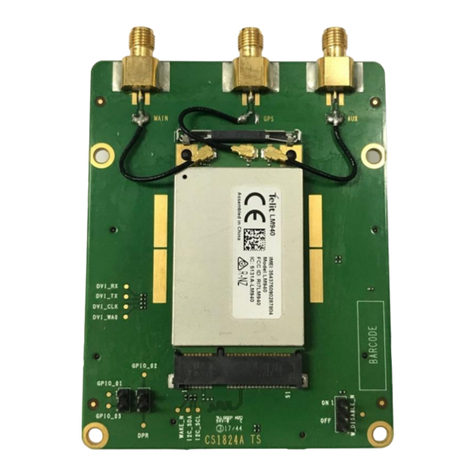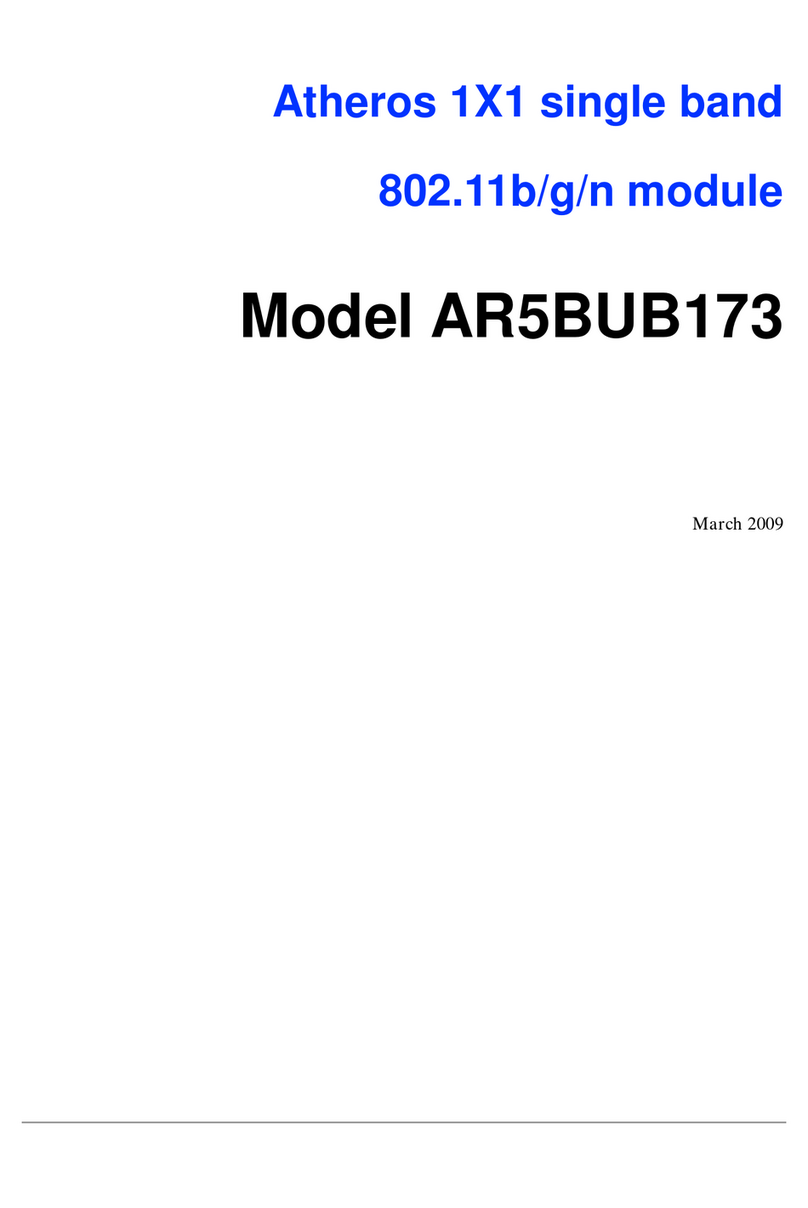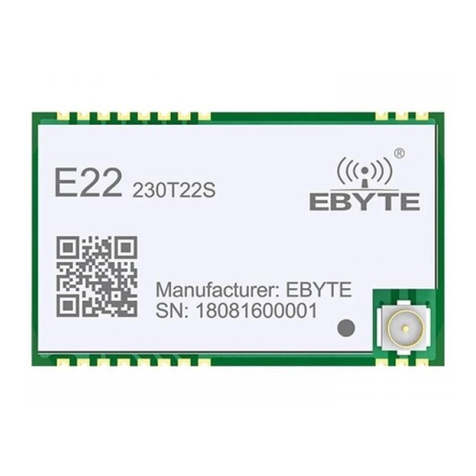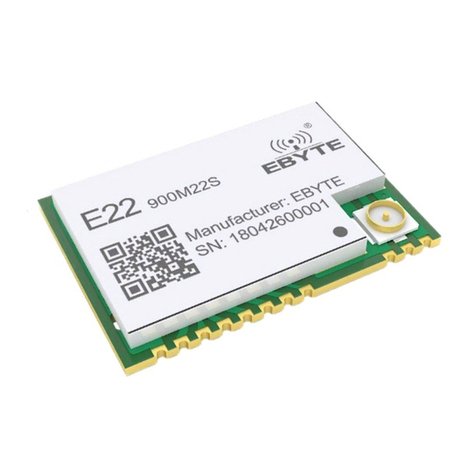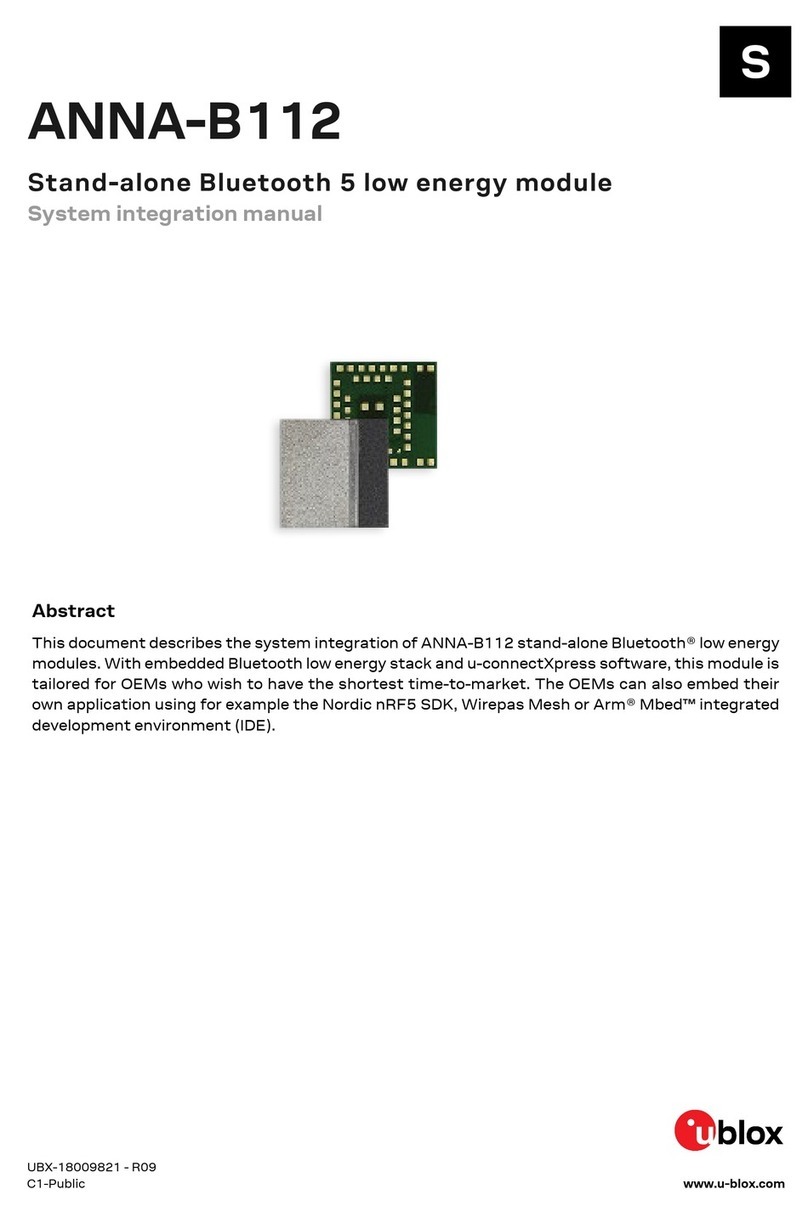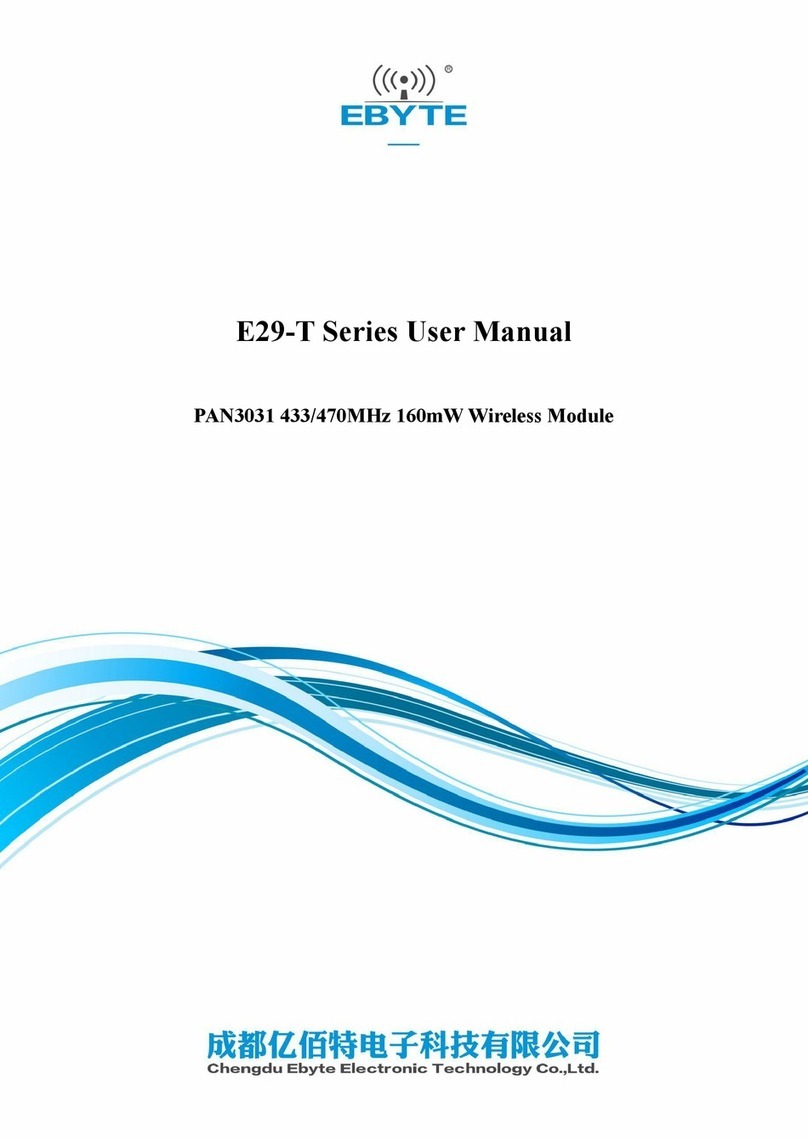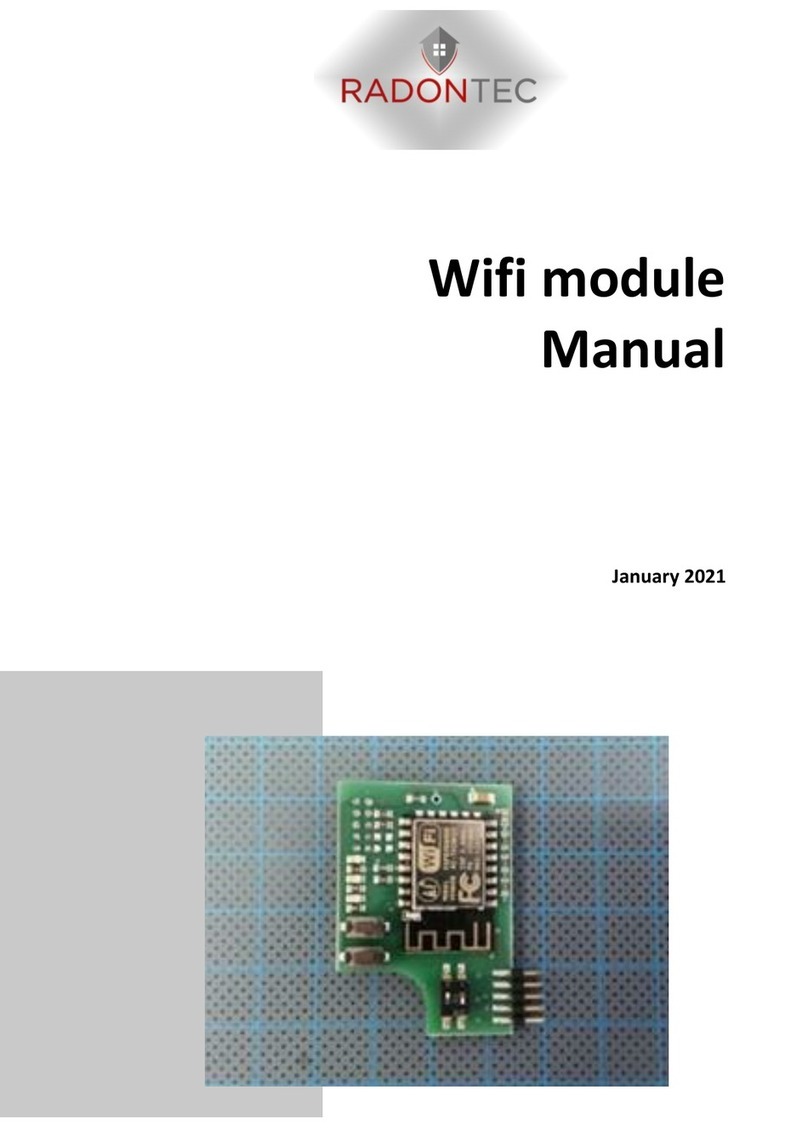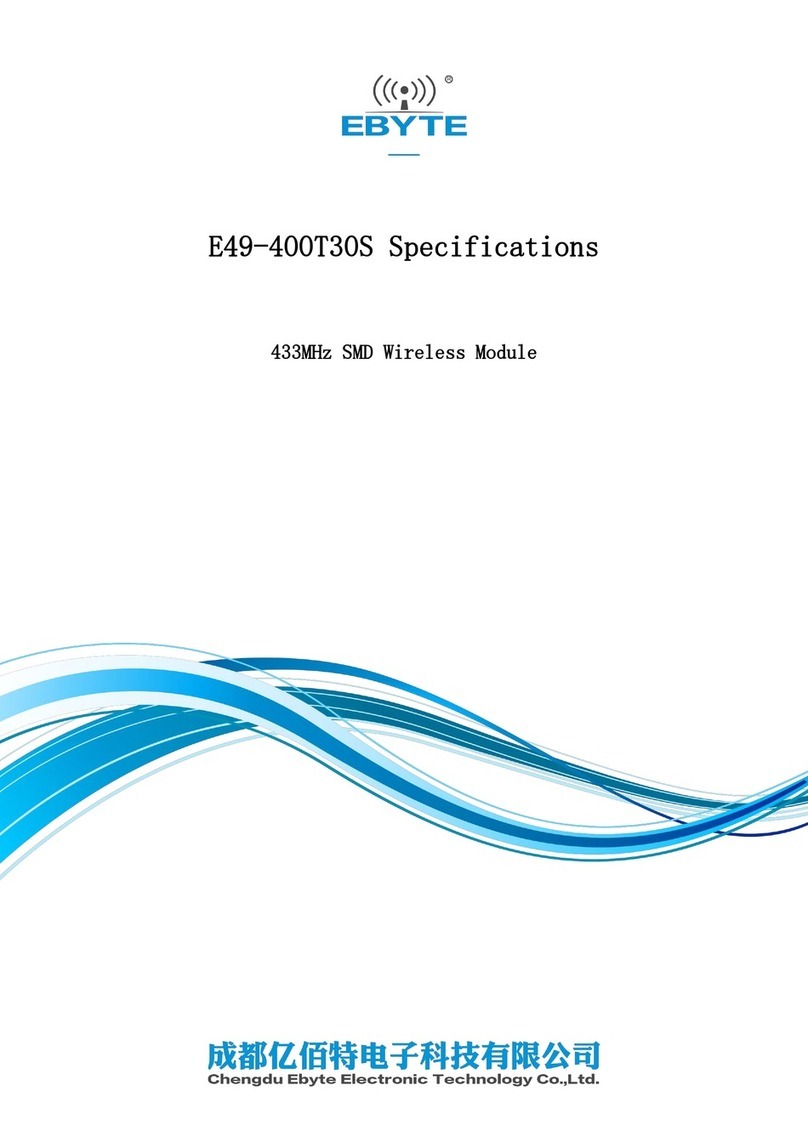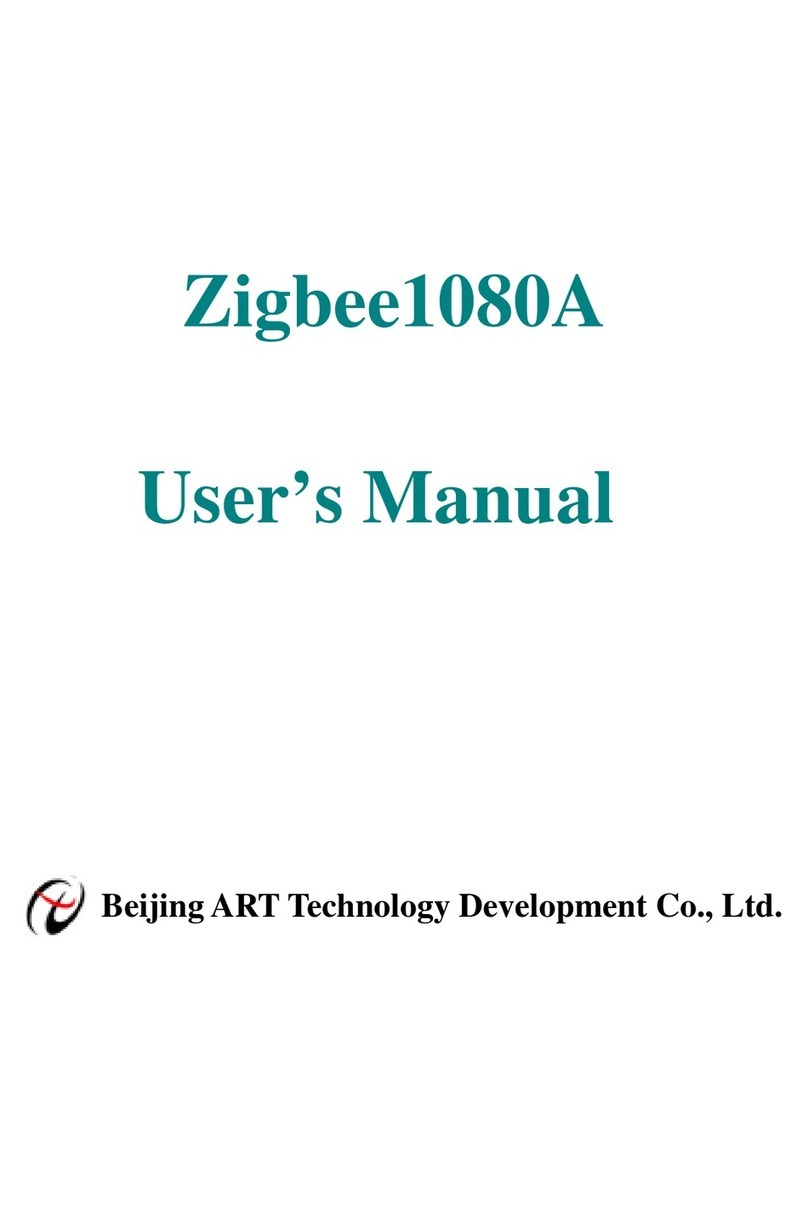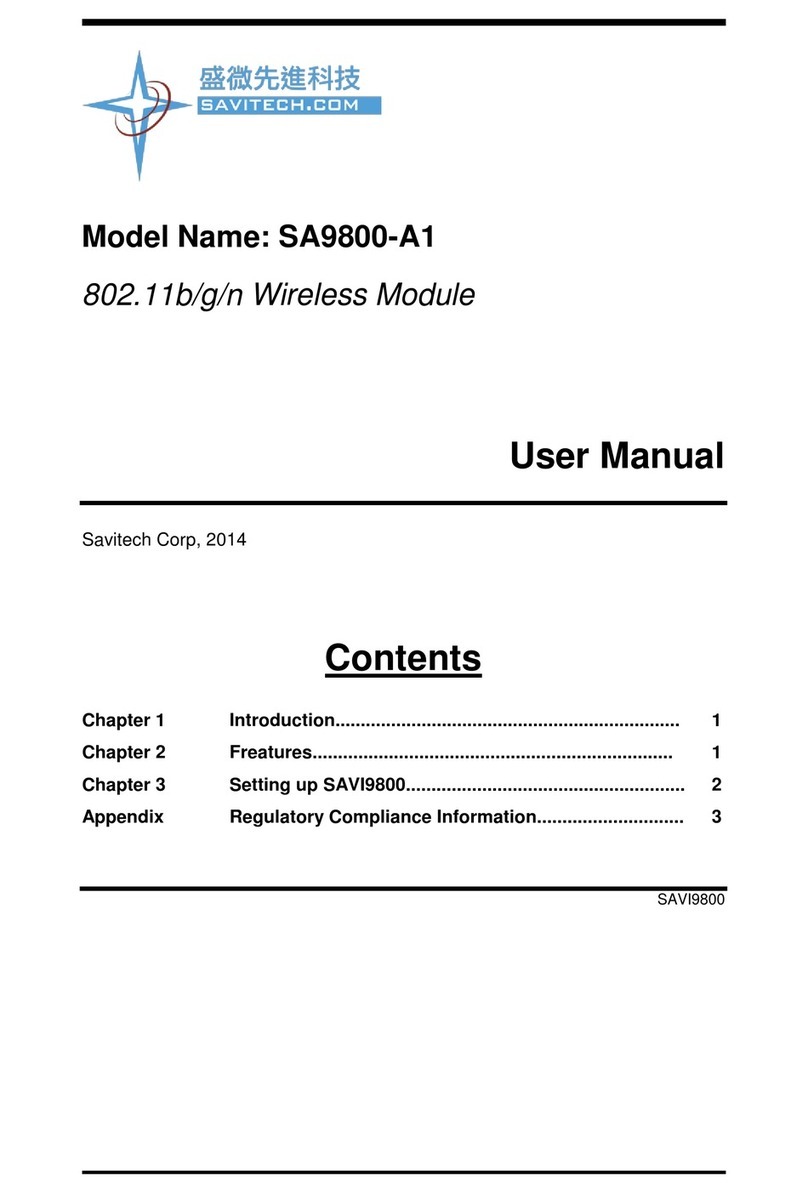Gemalto Cinterion ENS22-E Setup guide

Cinterion® ENS22-E
AT Command Set
Version: 01.000
DocId: ENS22-E_ATC_V01.000
GEMALTO.COM/M2M

Cinterion® ENS22-E AT Command Set
ENS22-E_ATC_V01.000 19/02/11
GENERAL NOTE
THE USE OF THE PRODUCT INCLUDING THE SOFTWARE AND DOCUMENTATION (THE "PRODUCT") IS
SUBJECT TO THE RELEASE NOTE PROVIDED TOGETHER WITH PRODUCT. IN ANY EVENT THE PROVI-
SIONS OF THE RELEASE NOTE SHALL PREVAIL. THIS DOCUMENT CONTAINS INFORMATION ON
GEMALTO M2M PRODUCTS. THE SPECIFICATIONS IN THIS DOCUMENT ARE SUBJECT TO CHANGE AT
DISCRETION OF GEMALTO M2M. GEMALTO M2M GMBH GRANTS A NON-EXCLUSIVE RIGHT TO USE
THE PRODUCT. THE RECIPIENT SHALL NOT TRANSFER, COPY, MODIFY, TRANSLATE, REVERSE ENGI-
NEER, CREATE DERIVATIVE WORKS; DISASSEMBLE OR DECOMPILE THE PRODUCT OR OTHERWISE
USE THE PRODUCT EXCEPT AS SPECIFICALLY AUTHORIZED. THE PRODUCT AND THIS DOCUMENT
ARE PROVIDED ON AN "AS IS" BASIS ONLY AND MAY CONTAIN DEFICIENCIES OR INADEQUACIES. TO
THE MAXIMUM EXTENT PERMITTED BY APPLICABLE LAW, GEMALTO M2M GMBH DISCLAIMS ALL WAR-
RANTIES AND LIABILITIES. THE RECIPIENT UNDERTAKES FOR AN UNLIMITED PERIOD OF TIME TO
OBSERVE SECRECY REGARDING ANY INFORMATION AND DATA PROVIDED TO HIM IN THE CONTEXT
OF THE DELIVERY OF THE PRODUCT. THIS GENERAL NOTE SHALL BE GOVERNED AND CONSTRUED
ACCORDING TO GERMAN LAW.
Copyright
Transmittal, reproduction, dissemination and/or editing of this document as well as utilization of its contents and
communication thereof to others without express authorization are prohibited. Offenders will be held liable for
payment of damages. All rights created by patent grant or registration of a utility model or design patent are
reserved.
Copyright © 2019, Gemalto M2M GmbH, Gemalto Company
Trademark Notice
Gemalto, the Gemalto logo, are trademarks and service marks of Gemalto and are registered in certain coun-
tries.
Microsoft and Windows are either registered trademarks or trademarks of Microsoft Corporation in the United
States and/or other countries. All other registered trademarks or trademarks mentioned in this document are
property of their respective owners.
Page 2 of 189
Document Name: Cinterion® ENS22-E AT Command Set
Version: 01.000
Date: February 11, 2019
DocId: ENS22-E_ATC_V01.000
Status

Cinterion® ENS22-E AT Command Set
Contents
ENS22-E_ATC_V01.000 19/02/11
Page 3 of 189
1. Introduction.............................................................................................................................................. 9
1.1 Scope of the document ................................................................................................................... 9
1.2 Related documents ....................................................................................................................... 10
1.3 Document Conventions ................................................................................................................. 12
1.3.1 Quick Reference Table .................................................................................................. 12
1.3.2 Superscript notation for parameters and values ............................................................ 13
1.4 AT Command Syntax .................................................................................................................... 14
1.4.1 Using Parameters .......................................................................................................... 14
1.5 Communication between Customer Application and Cinterion® ENS22-E.................................... 15
1.6 Supported character sets .............................................................................................................. 16
1.6.1 GSM alphabet tables and UCS2 character values ........................................................ 18
1.6.2 UCS2 and GSM character coding and conversion ........................................................ 20
1.6.2.1 Output of SIM data (UE to TE)....................................................................................... 20
1.6.2.2 Input of SIM data (TE to UE) ......................................................................................... 21
1.7 Unsolicited Result Code Presentation........................................................................................... 23
1.7.1 Common URCs.............................................................................................................. 23
1.8 Errors and Messages .................................................................................................................... 24
2. Configuration Commands.....................................................................................................................25
2.1 AT&F Reset AT Command Settings to Factory Default Values .................................................. 25
2.2 AT&V Display current configuration ............................................................................................ 26
2.2.1 AT&V responses............................................................................................................ 27
2.3 AT&W Store AT Command Settings to User Defined Profile ...................................................... 28
2.4 ATQ Result Code Presentation Mode......................................................................................... 29
2.5 ATV Result code format mode .................................................................................................... 30
2.5.1 Verbose and numeric result codes ................................................................................ 30
2.6 ATZ Restore AT Command Settings from User Defined Profile ................................................. 31
2.7 AT+CFUN Functionality Level..................................................................................................... 32
2.8 AT^SMSO Switch Off Cinterion® ENS22-E .................................................................................. 34
2.9 AT+CMEE Error Message Format .............................................................................................. 35
2.9.1 CME/CMS Error Code Overview ................................................................................... 36
2.10 AT+CSCS Character Set ............................................................................................................ 39
2.11 AT^SCFG Extended Configuration Settings ............................................................................... 40
2.12 AT^SPOW Set UART Mode and SLEEP Mode on UART .......................................................... 48
3. Serial Interface Control Commands.....................................................................................................49
3.1 AT\Q Flow Control....................................................................................................................... 49
3.2 AT&C Set Data Carrier Detect (DCD) Line Mode ....................................................................... 50
3.3 AT&D Set Data Terminal Ready (DTR) Line Mode..................................................................... 51
3.4 AT&S Set Data Set Ready (DSR) Line Mode ............................................................................. 52
3.5 ATE AT Command Echo ............................................................................................................. 53
3.6 AT+ICF Character Framing......................................................................................................... 54
3.7 AT+IPR Bit Rate.......................................................................................................................... 56
4. Identification Commands......................................................................................................................58
4.1 ATI Display product identification information .............................................................................58
4.2 AT+CGMI Request manufacturer identification........................................................................... 59
Contents

Cinterion® ENS22-E AT Command Set
Contents
ENS22-E_ATC_V01.000 19/02/11
Page 4 of 189
4.3 AT+CGMM Request model identification .................................................................................... 60
4.4 AT+CGMR Request revision identification and software version................................................ 61
4.5 AT+CGSN Request International Mobile Equipment Identity (IMEI)........................................... 62
4.6 AT+CIMI Request International Mobile Subscriber Identity (IMSI).............................................. 64
5. Security Commands.............................................................................................................................. 65
5.1 AT+CPIN PIN Authentication ...................................................................................................... 65
5.2 AT+CLCK Facility lock ................................................................................................................ 67
5.3 AT+CPWD Change Password ....................................................................................................69
6. Network Service Commands ................................................................................................................70
6.1 AT+COPN Read operator names ............................................................................................... 70
6.2 AT+COPS Operator Selection .................................................................................................... 71
6.3 AT+CESQ Extended Signal Quality ............................................................................................73
6.4 AT+CTZR Time Zone Reporting ................................................................................................. 75
6.5 AT+CPSMS Enable or Disable Power Saving Mode .................................................................. 77
6.6 AT^SMONI Monitoring Serving Cell ............................................................................................ 79
6.6.1 AT^SMONI Responses.................................................................................................. 79
6.6.2 Service states ................................................................................................................ 80
6.7 AT^SMONP Monitoring Neighbour Cells .................................................................................... 81
6.7.1 AT^SMONP Responses ................................................................................................ 81
6.8 AT+CEDRXS eDRX Setting........................................................................................................ 83
6.9 AT+CEDRXRDP Read dynamic eDRX parameters.................................................................... 86
6.10 AT^SNLWM2M Lwm2m Configuration Settings.......................................................................... 87
6.11 AT+CIPCA Initial PDP context activation .................................................................................... 91
7. Internet Service Commands................................................................................................................. 92
7.1 AT^SICS Internet Connection Setup Profile................................................................................ 95
7.1.1 Example: GPRS connection profile ............................................................................... 97
7.2 AT^SICI Internet Connection Information....................................................................................98
7.2.1 Checking Connection Profile Status .............................................................................. 99
7.3 AT^SIPS Internet Profile Storage.............................................................................................. 100
7.4 AT^SISS Internet Service Setup Profile .................................................................................... 102
7.5 AT^SISI Internet Service Information ........................................................................................ 105
7.6 AT^SISO Internet Service Open ............................................................................................... 107
7.7 AT^SISC Internet Service Close ............................................................................................... 110
7.8 AT^SISR Internet Service Read Data ....................................................................................... 111
7.8.1 Example: Socket Host Reads Small Amounts of UDP Data Packets (URC Mode)..... 113
7.9 AT^SISW Internet Service Write Data....................................................................................... 114
7.10 AT^SIST Enter Transparent Mode ............................................................................................116
7.11 AT^SISX Internet Service Execution......................................................................................... 118
7.12 AT^SISE Internet Service Error Report.....................................................................................120
7.13 Internet Service URC "^SIS" ....................................................................................................... 121
7.13.1 Information Elements Related to the Service Application............................................ 122
7.14 Examples of how to Configure and Use Internet Service Profiles............................................... 124
7.14.1 Selecting URC Mode or Polling Mode ......................................................................... 124
7.14.2 UDP Scenario ..............................................................................................................124
7.14.3 Creating Transparent UDP Socket Client .................................................................... 126
7.14.4 Opening and Closing Transparent UDP Service ......................................................... 126
7.14.5 Ping.............................................................................................................................. 127

Cinterion® ENS22-E AT Command Set
Contents
ENS22-E_ATC_V01.000 19/02/11
Page 5 of 189
8. Packet Domain Related Commands ..................................................................................................128
8.1 AT+CGACT PDP context activate or deactivate ....................................................................... 128
8.2 AT+CGATT PS attach or detach...............................................................................................130
8.3 AT+CGAUTH Define PDP Context Authentication Parameters................................................ 131
8.4 AT+CGDCONT Define PDP Context ........................................................................................ 133
8.5 AT+CEREG EPS Network Registration Status ......................................................................... 135
8.6 AT+CGPADDR Show PDP Address ......................................................................................... 138
8.7 AT+CSODCP Sending of originating data via the control plane ............................................... 140
8.8 AT+CRTDCP Reporting of terminating data via the control plane ............................................ 142
9. Short Message Service (SMS) Commands........................................................................................ 144
9.1 SMS Parameters ......................................................................................................................... 144
9.2 AT+CMGC Send SMS Command............................................................................................. 145
9.3 AT+CMGS Send SMS............................................................................................................... 146
9.4 AT+CNMA New Message Acknowledgement to UE/TE ........................................................... 147
9.5 AT+CSCA SMS Service Center Address.................................................................................. 148
9.6 AT+CSMS Select Message Service.......................................................................................... 149
10. (U)SIM related Commands.................................................................................................................. 151
10.1 AT+CCID (U)SIM Card Identification Number........................................................................... 151
11. Miscellaneous Commands.................................................................................................................. 152
11.1 ATS3 Command Line Termination............................................................................................ 152
11.2 ATS4 Response Formatting ...................................................................................................... 153
11.3 ATS5 Command Line Editing .................................................................................................... 154
11.4 AT^SBNR Binary Read ............................................................................................................. 155
11.5 AT^SBNW Binary Write............................................................................................................. 157
11.6 +++ Escape from Data Mode to AT Command Mode ............................................................... 158
11.7 AT^SNFWPUPDS Incremental Firmware Update..................................................................... 159
12. Hardware related Commands............................................................................................................. 161
12.1 AT+CCLK Real Time Clock....................................................................................................... 161
12.2 AT^SBV Battery/Supply Voltage ............................................................................................... 162
12.3 AT^SCTM Critical Operating Temperature Monitoring.............................................................. 163
12.4 AT^SSPI Serial Protocol Interface ............................................................................................ 165
12.4.1 Selecting SPI Mode ..................................................................................................... 167
12.4.2 Transmitting Data over AT Interface............................................................................ 168
12.4.2.1 Structure of Messages on the I²C Bus ......................................................................... 169
12.4.2.2 Structure of Messages on the SPI ............................................................................... 170
12.4.3 Error Handling on the I²C Bus...................................................................................... 170
12.4.4 Example: Using I²C Bus............................................................................................... 172
12.4.5 Error Handling on the SPI Bus..................................................................................... 172
12.4.6 Example: Transfer and Response Messages on SPI .................................................. 173
13. General Purpose I/O (GPIO) Pin related Commands........................................................................ 174
13.1 AT^SPIO GPIO Driver Open/Close........................................................................................... 174
13.2 AT^SCPIN Pin Configuration .................................................................................................... 175
13.2.1 GPIO Configuration Table ........................................................................................... 176
13.3 AT^SGIO Get IO State of a Specified Pin ................................................................................. 177
13.4 AT^SSIO Set IO State of a Specified Pin.................................................................................. 178

Cinterion® ENS22-E AT Command Set
Contents
ENS22-E_ATC_V01.000 19/02/11
Page 6 of 189
14. Appendix ..............................................................................................................................................179
14.1 Restricted access to SIM data after SIM PIN authentication....................................................... 179
14.2 Available AT Commands and Dependency on SIM PIN ............................................................. 180
14.3 AT Command Settings storable with AT&W................................................................................ 183
14.4 Factory Default Settings Restorable with AT&F.......................................................................... 184
14.5 Summary of Unsolicited Result Codes (URC)............................................................................. 185
14.6 Alphabetical List of AT Commands ............................................................................................. 187

Cinterion® ENS22-E AT Command Set
List of Tables
ENS22-E_ATC_V01.000 19/02/11
Page 7 of 189
Table 1.1: Symbols used to mark the type of parameters ...........................................................................13
Table 1.2: Symbols used to indicate storage options or correlations with other commands ....................... 13
Table 1.3: Symbols used to mark different types of default values of parameters ..................................... 13
Table 1.4: Types of AT commands and responses .................................................................................... 14
Table 1.5: Exemplary escape sequences generated by Cinterion® ENS22-E for its non-UCS2
output ......................................................................................................................................... 17
Table 2.1: General "CME ERROR" Codes (3GPP TS 27.007) ................................................................. 36
Table 2.2: General "CME ERROR" Codes (proprietary) ........................................................................... 37
Table 2.3: EPS related "CME ERROR" Codes (3GPP TS 27.007) ........................................................... 38
Table 2.4: SMS related "CMS ERROR" Codes (3GPP TS 27.005) .......................................................... 38
Table 7.1: Applicability of AT^SICS <conParmTag> values ..................................................................... 95
Table 7.2: Applicability of AT^SISS <srvParmTag> values ................................................................... 102
Table 12.1: Special characters for ASCII coding ......................................................................................... 168
Table 12.2: Structure of Transfer and Response Messages on the I²C bus................................................ 169
Table 12.3: Structure of Transfer and Response Messages for SPI ........................................................... 170
Table 14.1: Available AT Commands and Dependency on SIM PIN........................................................... 180
Table 14.2: Settings Stored to User Profile on ASC0 .................................................................................. 183
Table 14.3: Factory Default Settings Restorable with AT&F ....................................................................... 184
Table 14.4: Summary of Unsolicited Result Codes (URC) .......................................................................... 185
Table 14.5: Alphabetical List of AT Commands........................................................................................... 187
List of Tables

Cinterion® ENS22-E AT Command Set
List of Figures
ENS22-E_ATC_V01.000 19/02/11
Page 8 of 189
Figure 1.1: Main character table of GSM 7 bit default alphabet.................................................................... 18
Figure 1.2: Extension character table of GSM 7 bit default alphabet............................................................ 19
Figure 12.1: SPI modes selectable on SPI ................................................................................................... 167
List of Figures

Cinterion® ENS22-E AT Command Set
1. Introduction
ENS22-E_ATC_V01.000 19/02/11
Page 9 of 189
1. Introduction
1.1 Scope of the document
This document presents the AT Command Set for
Cinterion® ENS22-E LTE Engine, Release 01.000.
Before using the Cinterion® ENS22-E or upgrading to a new firmware version please read the latest product
information provided in "Cinterion® ENS22-E Release Notes, Version 01.000".
More information is available at http://m2m.gemalto.com/.
DISCLAIMER:
AT commands or parameters not documented in this document are subject to change and reserved for future
use. Gemalto M2M GmbH reserves the right to modify oreven eliminate these options in later releases.
Cinterion® ENS22-E features packet switched (PS) data capability, but does not support circuit switched (CS)
data trans-mission. Hoewever, for reasons of compatibility with other products, and for compliance with 3GPP
TS specifi-catiions, some AT commands imply parameters or values related to CS data capability.

Cinterion® ENS22-E AT Command Set
1.2 Related documents
ENS22-E_ATC_V01.000 19/02/11
Page 10 of 189
1.2 Related documents
[1] Cinterion® ENS22-E Release Notes, Version 01.000
[2] Cinterion® ENS22-E Hardware Interface Description, Version 01.000
[3] Application Note 16: Updating Cinterion® ENS22 Firmware
[4] Application Note 62: Transport Layer Security for Client TCP/IP Services
[5] 3GPP TR 21.905 (descendant of 3GPP TR 01.04): Vocabulary for 3GPP Specifications
[6] International Organization for Standardization (ISO): ISO/IEC10646: Universal Multiple-Octet Coded Char-
acter Set (UCS) - Part 1: Architecture and Basic Multilingual Plane.
This international standard is closely related to the Unicode Standard published by the Unicode Consortium
[7] The Unicode Consortium: Mapping of ETSI GSM 03.38 7-bit default alphabet characters into Unicode
[.TXT!]
[8] ITU-T V.24 List of definitions for interchange circuits between data terminal equipment (DTE) and data cir-
cuit-terminating equipment (DCE)
[9] ITU-T V.250 Serial asynchronous automatic dialling and control
[10] 3GPP TS 11.11: Specification of the Subscriber Identity Module - Mobile Equipment (SIM - ME) interface
[11] 3GPP TS 31.101: UICC-terminal interface; Physical and logical characteristics
[12] 3GPP TS 31.102: Characteristics of the Universal Subscriber Identity Module (USIM) application
[13] ETSI TS 102 221: Smart Cards; UICC-Terminal interface; Physical and logical characteristics
[14] 3GPP TS 11.14: Specification of the SIM Application Toolkit for the Subscriber Identity Module - Mobile
Equipment (SIM - ME) interface
[15] 3GPP TS 31.111: Universal Subscriber Identity Module (USIM) Application Toolkit (USAT)
[16] ETSI TS 102 223: Smart Cards; Card Application Toolkit (CAT)
[17] 3GPP TS 22.002 (descendant of 3GPP TS 22.02): Circuit Bearer Services (BS) supported by a Public Land
Mobile Network (PLMN)
[18] 3GPP TS 22.004 (descendant of 3GPP TS 02.04): General on supplementary services
[19] 3GPP TS 22.030 (descendant of 3GPP TS 02.30): Man-Machine Interface (MMI) of the Mobile Station (MS)
[20] 3GPP TS 22.060 (descendant of 3GPP TS 02.60): General Packet Radio Service (GPRS); Service descrip-
tion; Stage 1
[21] 3GPP TS 23.060 (descendant of 3GPP TS 03.60): General Packet Radio Service (GPRS); Service descrip-
tion; Stage 2
[22] 3GPP TS 22.081 (descendant of 3GPP TS 02.81): Line Identification Supplementary Services; Stage 1
[23] 3GPP TS 22.082 (descendant of 3GPP TS 02.82): Call Forwarding (CF) Supplementary Services; Stage 1
[24] 3GPP TS 22.083 (descendant of 3GPP TS 02.83): Call Waiting (CW) and Call Holding (HOLD); Supple-
mentary Services; Stage 1
[25] 3GPP TS 22.085 (descendant of 3GPP TS 02.85): Closed User Group (CUG) supplementary services;
Stage 1
[26] 3GPP TS 22.088 (descendant of 3GPP TS 02.88): Call Barring (CB) supplementary services; Stage 1
[27] 3GPP TS 22.090 (descendant of 3GPP TS 02.90): Unstructured Supplementary Service Data (USSD);
Stage 1
[28] 3GPP TS 23.038 (descendant of 3GPP TS 03.38): Alphabets and language specific information
[29] 3GPP TS 23.040 (descendant of 3GPP TS 03.40): Technical realization of the Short Message Service
(SMS)
[30] 3GPP TS 23.041 (descendant of 3GPP TS 03.41): Technical realization of Cell Broadcast Service (CBS)
[31] 3GPP TS 23.107: Quality of Service (QoS) concept and architecture
[32] 3GPP TS 24.011 (descendant of 3GPP TS 04.11): Point-to-Point (PP) Short Message Service (SMS) sup-
port on mobile radio interface
[33] 3GPP TS 24.008 (descendant of 3GPP TS 04.08): Mobile radio interface Layer 3 specification; Core net-
work protocols; Stage 3

Cinterion® ENS22-E AT Command Set
1.2 Related documents
ENS22-E_ATC_V01.000 19/02/11
Page 11 of 189
[34] 3GPP TS 24.080 (descendant of 3GPP TS 04.80): Mobile radio interface layer 3 supplementary services
specification; Formats and coding
[35] 3GPP TS 24.301 Non-Access-Stratum (NAS) protocol for Evolved Packet System (EPS)
[36] 3GPP TS 25.331 Radio Resource Control (RRC)
[37] 3GPP TS 25.133 Requirements for support of radio resource management
[38] 3GPP TS 27.005 (descendant of 3GPP TS 07.05): Use of Data Terminal Equipment - Data Circuit terminat-
ing Equipment (DTE - DCE) interface for Short Message Service (SMS) and Cell Broadcast Service (CBS)
[39] 3GPP TS 27.007 (descendant of 3GPP TS 07.07): AT command set for User Equipment (UE)
[40] 3GPP TS 27.060 (descendant of 3GPP TS 07.60): Mobile Station (MS) supporting Packet Switched Ser-
vices
[41] 3GPP TS 22.101 (descendant of 3GPP TS 02.07 and 3GPP TS 02.40): Service principles
[42] Common PCN Handset Specification (CPHS) v4.2 [.ZIP!]
[43] 3GPP TS 36.133 Evolved Universal Terrestrial Radio Access (E-UTRA); Requirements for support of radio
resource management
[44] 3GPP TS 45.008 (descendant of GSM 05.08): Radio subsystem link control

Cinterion® ENS22-E AT Command Set
1.3 Document Conventions
ENS22-E_ATC_V01.000 19/02/11
Page 12 of 189
1.3 Document Conventions
Throughout this document Cinterion® ENS22-E is also referred to as LTE Engine or short UE, MS (Mobile
Station) or Mobile Terminal (MT). In related documents the equivalent term DCE (Data Communication
Equipment) may be found. AT commands are used to control the Cinterion®ENS22-E. The controlling device
is referred to as Customer Application or short TE. Related documents may use the equivalent term DTE
(Data Terminal Equipment).
All abbreviations and acronyms used throughout this document are based on 3GPP specifications. For
defini-tions please refer to 3GPP TR 21.905 [5].
1.3.1 Quick Reference Table
Each AT command description includes a table similar to the example shown below. The table is intended as a
quick reference to indicate the following functions:
Example:
PIN: Is the AT command PIN protected?
+Yes
-No
±Usage is dependent on conditions specified for the command, or not all command types are PIN
protected (for example write command PIN protected, read command not).
Note: The table provided in Section 14.2, Available AT Commands and Dependency on SIM
PIN uses the same symbols.
Last: If commands are concatenated, this AT command must be the last one.
+Yes
-No
Note: See also Section 1.4, AT Command Syntax for details on concatenated AT commands.
PIN Last
- -

Cinterion® ENS22-E AT Command Set
1.3 Document Conventions
ENS22-E_ATC_V01.000 19/02/11
Page 13 of 189
1.3.2 Superscript notation for parameters and values
Table 1.1: Symbols used to mark the type of parameters
Table 1.2: Symbols used to indicate storage options or correlations with other commands
Table 1.3: Symbols used to mark different types of default values of parameters
Parameter type Meaning
<param>(num) Parameter value must be numeric type.
<param>(str) Parameter value must be string type.
<param>(text) Parameter value is a string according to selected character set. Not enclosed in
double quotes
<param>(u) Unspecified, i.e. parameter value may be numeric or string type.
Parameter option Meaning
<param>(+CSCS) Parameter value has to be (is) coded according to current setting of <chset> (see
AT+CSCS for details)
<param>(&W) Parameter value is stored to user profile in non-volatile memory after executing
AT&W
<param>(&V) Parameter value is displayed by AT&V
<param>(NV) Parameter is stored in non-volatile memory.
Value option Meaning
[x] Default value set if parameter is omitted.
x(&F) Factory value restored by AT&F
x(P) Powerup value of a parameter not stored in non-volatile memory.
x(D) Delivery value of a parameter which may be overridden from non-volatile setting
(refer to symbol (NV) and symbol (&W) above).

Cinterion® ENS22-E AT Command Set
1.4 AT Command Syntax
ENS22-E_ATC_V01.000 19/02/11
Page 14 of 189
1.4 AT Command Syntax
The "AT" or "at" prefix must be set at the beginning of each command line. To terminate a command line enter
<CR>. Commands are usually followed by a response that includes "<CR><LF><response><CR><LF>".
Throughout this document, only the responses are presented, <CR><LF> are omitted intentionally.
Table 1.4: Types of AT commands and responses
1.4.1 Using Parameters
• Multiple parameters are separated by commas. This applies to write commands, command responses, URCs
and result codes. Please note that throughout this document spaces behind commas may be added for better
readability.
•Optional parameters are enclosed in square brackets. If optional parameters are omitted, the current settings
are used until you change them.
• Optional parameters or subparameters can be omitted unless they are followed by other parameters. If you
want to omit a parameter in the middle of a string it must be replaced by a comma.
•A parameter value enclosed in square brackets represents the value that will be used if an optional parameter
is omitted.
•When the parameter is a character string the string must be enclosed in quotation marks. Symbols in quota-
tion marks will be recognized as strings.
•All spaces will be ignored when using strings without quotation marks.
• It is possible to omit the leading zeros of strings which represent numbers.
• If an optional parameter of a ITU-T V.250 command is omitted, its value is assumed to be 0.
AT command type Syntax Function
Test command AT+CXXX=? The test response returns supported parameters and supported
values. Values can be shown as a list of single values or a range,
for example, (1,2,3) or (1-3).
Read command AT+CXXX? This command returns the currently set value of the parameter or
parameters.
Write command AT+CXXX=<...> This command sets user-definable parameter values.
Exec(ution) command AT+CXXX The execution command reads non-variable parameters deter-
mined by internal processes in the UE.

Cinterion® ENS22-E ATCommand Set
1.5 Communication between Customer Application and
Cinterion® ENS22-E
ENS22-E_ATC_V01.000 19/02/11
Page 15 of 189
1.5 Communication between Customer Application and Cinterion®
ENS22-E
After power-up or restart ensure that the UE is in ready state before trying to send any AT command or data.
For detailed information on timing conditions, signal states and particularly the startup behavior of the
Cinterion® ENS22-E's signal lines refer to the Hardware Interface Description [2].
Leaving hardware flowcontrol unconsidered the Customer Application (TE) is coupled with the Cinterion®
ENS22-E (UE) via a receive and a transmit line.
Since both lines are driven by independent devices collisions may (and will) happen. For example, if the TE
issues an AT command and the Cinterion® ENS22-E starts sending a URC. This will probably cause the TE to
misinterpret the URC being part of the AT command's response. To avoidthis conflict the following measures
must be taken:
• If an AT command is finished (with "OK" or "ERROR") the TE shall always wait at least 100 ms before sending
the next one. This applies to bit rates of 9600 bps or higher (see AT+IPR). At bit rates below 9600 bps the
delay must be longer: 300 ms at 1200 bps, and 500 ms at 300 bps.
The pause between two AT commands gives the Cinterion® ENS22-E the opportunity to the transmission
of pending URCs and get necessary service.
•The TE shall communicate with the Cinterion® ENS22-E using activated echo (ATE1), i.e. the Cinterion®
ENS22-E echoes charac-ters received from the TE.
Hence, when the TEreceives theecho of the first character "A" of the AT command just sent by itself it has
control both over the receive and the transmit paths.
Using Backspace at command line:
• As the standard GSM alphabet does not provide a backspace functionality the Cinterion® ENS22-E is
designed to use the character "08"(hex 0x08) as backspace for command line input. This allows the user to
easily erase the last character when writing an AT command. On the other hand, this solution requires
entering theescape sequence \08 for writing the "ò" character in GSM character string parameters.
•If command echo is enabled (ATE1) Backspace may cause 08 - 32 - 08 (decimal) character sequence or no
echo, depending on serial interface and speed of character input.

Cinterion® ENS22-E AT Command Set
1.6 Supported character sets
ENS22-E_ATC_V01.000 19/02/11
Page 16 of 189
1.6 Supported character sets
Cinterion® ENS22-E supports two character sets: GSM 7 bit, also referred to as GSM alphabet or SMS
alphabet (3GPP TS 23.038 [28]) and UCS216 bit (ISO-10646 [6]). See AT+CSCS for information about
selecting the character set. Character tables can be found below.
Explanation of terms
• Escape Character
There are two types of escape sequences which lead to an alternative interpretation on subsequent charac-
ters by the UE:
- AT command interface
Escape sequences starting with character value 0x5C are used for the UE's non-UCS2 input and output.
-GSM 7 bit default alphabet
If the escape sequence used within a text starts with character value 0x1B in the GSM 7 bit default alpha-
bet, which represents the extension character and needs to be correctly interpreted by the TE, both for
character input and output. To the Cinterion® ENS22-E, an escape sequence appears like any other
byte received or sent.
•TE Character Set
The character set currently used by the Customer Application is selected with AT+CSCS. It is recommended
to select UCS2 setting.
•Data Coding Scheme (DCS)
DCS is part of a short message and is saved on the SIM.
•International Reference Alphabet (IRA)
The International Reference Alphabet is equivalent to ASCII (American Standard Code for Information Inter-
change) and ISO 646, i.e. it defines a 7-bit coded character set. The mapping can be obtained from the char-
acter set tables below (UCS2 values 0x0000 to 0x007F).
When you enter characters that are not valid characters of the supported alphabets the behavior is undefined.
If GSM alphabet is selected, all characters sent over the serial line (between TE and UE) must be in the range
from 0 to 127 (7 bit range).
Note: If the UE is configured for GSM alphabet, but the Customer Application (TE) uses ASCII, bear in mind that
some characters have different code values, such as the following:
• "@" character with GSM alphabet value 0 is not displayable by an ASCII terminal program, e.g. Microsoft©
Hyperterminal®.
• "@" character with GSM alphabet value 0 will terminate any C string! This is because value 0 is defined as C
string end tag. Therefore, the GSM Null character will cause problems on application level when using 'C'-
functions, e.g. "strlen()". Using an escape sequence as shown in the table below solves the problem. By the
way, this may be the reason why even network providers sometimes replace '@' with "@=*" in their SIM appli-
cation.
• Some other characters of the GSM alphabet may be misinterpreted by an ASCII terminal program. For exam-
ple, GSM "ö" (as in "Börse") is assumed to be "|" in ASCII, thus resulting in "B|rse". This is because in both
alphabets there are different characters assigned to value 7C (hexadecimal).
If the TE sends characters differently coded or undefined in ASCII or GSM (e.g. Ä, Ö, Ü) it is possible to use
escape sequences. The UE's input parser translates the escape sequence to the corresponding GSM character
value.
Note:
The UE also uses escape sequences for its non-UCS2 output: Quotation mark (") and the escape character itself
(\, respectively Ö in GSM alphabet) are converted, as well as all characters with a value below 32 (hexadecimal
0x20).
Hence, the input parser of the Customer Application needs to be able to translate escape sequences back to the
corresponding character of the currently used alphabet.
Unsupported characters are shown as a space (hexadecimal 0x20).

Cinterion® ENS22-E AT Command Set
1.6 Supported character sets
ENS22-E_ATC_V01.000 19/02/11
Page 17 of 189
Table 1.5: Exemplary escape sequences generated by Cinterion®ENS22-E for its non-UCS2 output
Usually terminal programs are not able to recognize escape sequences, and thus, handle them as normal char-
acters.
To prevent misinterpretation of control characters or special characters it is recommended to always use UCS2
alphabet and PDU mode.
Character
Value
ASCII
Character
GSM
Character
UCS2
Character
Escape
Sequence
Numeric Escape
Sequence
0x5C \ Ö 00D6 \5C 0x5C 0x35 0x43
0x22 ""0022 \22 0x5C 0x32 0x32
0x00 NULL @n/a \00 0x5C 0x30 0x30

Cinterion® ENS22-E AT Command Set
1.6 Supported character sets
ENS22-E_ATC_V01.000 19/02/11
Page 18 of 189
1.6.1 GSM alphabet tables and UCS2 character values
This section provides tables for the GSM default alphabet (3GPP TS 23.038 [28]) supported by the
Cinterion® ENS22-E. Below any GSM character find the corresponding two byte character value of the
UCS2 alphabet. For details refer to "ETSI GSM 03.38 mapping into Unicode" [7].
1) This code is an escape to the following extension of the 7 bit default alphabet table.
2) This code is not a printable character and therefore not defined for the UCS2 alphabet. It shall be treated as the accom-
panying control character.
3) See Section 1.5 for further details on using backspace and "ò" character.
Figure 1.1: Main character table of GSM 7 bit default alphabet

Cinterion® ENS22-E AT Command Set
1.6 Supported character sets
ENS22-E_ATC_V01.000 19/02/11
Page 19 of 189
1) This code value is reserved for the extension to another extension table. On receipt of this code, a receiving entity shall
display a space until another extension table is defined.
2) This code represents the EURO currency symbol. The code value is the one used for the character 'e'. Therefore a receiv-
ing entity which is incapable of displaying the EURO currency symbol will display the character 'e' instead.
3) This code is defined as a Page Break character and may be used for example in compressed CBS messages. Any mobile
which does not understand the 7 bit default alphabet table extension mechanism will treat this character as Line Feed.
Figure 1.2: Extension character table of GSM 7 bit default alphabet

Cinterion® ENS22-E AT Command Set
1.6 Supported character sets
ENS22-E_ATC_V01.000 19/02/11
Page 20 of 189
If the Customer Application receives a code where a symbol is not represented in Figure 1.2, Extension character
table of GSM 7 bit default alphabet it shall display the character shown in the main GSM 7 bit default alphabet
table (see Figure 1.1, Main character table of GSM 7 bit default alphabet).
1.6.2 UCS2 and GSM character coding and conversion
This section provides basic information on how to handle input and output character conversion, e.g. for SMS
text mode, if the character representation of UE and Customer Application differ, i.e. if the Data Coding Scheme
and the TE character set use different mappings.
1.6.2.1 Output of SIM data (UE to TE)
Note: The ratio of SIM bytes to output bytes is given in parentheses.
Case 1
Every GSM character is sent to the TE as it is (8-bit value with highest bit set to zero).
Example: 47'H, 53'H, 4D'H →47'H, 53'H, 4D'H, displayed as "GSM"
Case 2
Every data byte is sent to the TE as 2 IRA characters each representing a halfbyte.
Example: B8'H (184 decimal) →42'H, 38'H, displayed as "B8"
Case 3
Every 16-bit UCS2 value is sent to the TE as 4 IRA characters.
Example: C4xA7'H (50343 decimal) →43'H, 34'H, 41'H, 37'H, displayed as "C4A7"
Problem: An odd number of bytes leads to an error because there are always two bytes needed for each UCS2
character
Case 4
Every GSM character is sent to the TE as 4 IRA characters to show UCS2 in text mode.
Example: 41'H ("A") →30'H, 30'H, 34'H, 31'H, displayed as "0041"
Case 5
Every data byte is sent to the TE as IRA representation of UCS2 (similar to case 4).
Example: B2'H →30'H, 30'H, 42'H, 32'H, displayed as "00B2"
Case 6
Every 16-bit value is sent to the TE as IRA representation of it. It is assumed that number of bytes is even.
Example: C3x46'H →43'H, 33'H, 34'H, 36'H, displayed as "C346"
Used character set DCS = 7 bit
GSM
DCS = 8 bit
Data
DCS = 16 bit
UCS2
GSM Case 1
GSM (1:1)
Case 2
8 bit to IRA (1:2)
Case 3
UCS2 to IRA (2:4)
UCS2 Case 4
GSM to IRA (1:4)
Case 5
8 bit to IRA (1:4)
Case 6
UCS2 to IRA (2:4)
Table of contents
